Gillingham, Kent: Difference between revisions
Created page with '{{Infobox town |name=Gillingham |county=Kent |picture=GillinghamHighSt3952.JPG |picture caption=Mill Road, Gillingham |os grid ref=TQ775675 |latitude=51.3792 |longitude=0.5498 |p…' |
m clean up, typos fixed: pronunced → pronounced, interst → interest |
||
| Line 17: | Line 17: | ||
'''Gillingham''' is a town in [[Kent]], one of the Medway towns; those naval and industrial towns clustered around the mouth of the [[River Medway]] as it opens on the [[Thames Estuary]]. | '''Gillingham''' is a town in [[Kent]], one of the Medway towns; those naval and industrial towns clustered around the mouth of the [[River Medway]] as it opens on the [[Thames Estuary]]. | ||
Like neighbouring [[Chatham]], Gillingham grew thanks to the | Like neighbouring [[Chatham]], Gillingham grew thanks to the interest of the Royal Navy. Also like Chatham it has had to cope with a severe depression in its fortunes since the Chatham Dockyard closed. | ||
The town grew along the road from Brompton on the great lines (military barracks), to the railway station. As such it was a linear development. Close by was the road along the shore line, linking The Strand, and the tiny village of Gillingham Green. Later, communiites developed along the top road, [[Watling Street]], a turnpike road linking Chatham with Dover. All these communities merged into the town that is called today Gillingham. | The town grew along the road from Brompton on the great lines (military barracks), to the railway station. As such it was a linear development. Close by was the road along the shore line, linking The Strand, and the tiny village of Gillingham Green. Later, communiites developed along the top road, [[Watling Street]], a turnpike road linking Chatham with Dover. All these communities merged into the town that is called today Gillingham. | ||
==Name== | ==Name== | ||
The initial “G” is | The initial “G” is pronounced soft (''dƷ'') in contrast to [[Gillingham, Dorset|Gillingham]], which has a hard G. The name "Gillingham" means a ''Homestead of Gylla's clan'', from the Old English ''Gyllingaham''. It was first recorded in 10th century as ''Gyllingeham''. | ||
The town has also been referred to in old texts as ''Jillyingham Water''. | The town has also been referred to in old texts as ''Jillyingham Water''. | ||
Latest revision as of 20:57, 27 January 2016
| Gillingham | |
| Kent | |
|---|---|
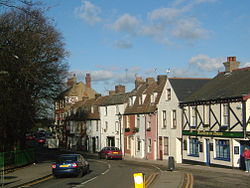 Mill Road, Gillingham | |
| Location | |
| Grid reference: | TQ775675 |
| Location: | 51°22’45"N, 0°32’59"E |
| Data | |
| Population: | 99,773 (2001) |
| Post town: | Gillingham |
| Postcode: | ME7 |
| Dialling code: | 01634 |
| Local Government | |
| Council: | Medway |
| Parliamentary constituency: |
Gillingham and Rainham |
Gillingham is a town in Kent, one of the Medway towns; those naval and industrial towns clustered around the mouth of the River Medway as it opens on the Thames Estuary.
Like neighbouring Chatham, Gillingham grew thanks to the interest of the Royal Navy. Also like Chatham it has had to cope with a severe depression in its fortunes since the Chatham Dockyard closed.
The town grew along the road from Brompton on the great lines (military barracks), to the railway station. As such it was a linear development. Close by was the road along the shore line, linking The Strand, and the tiny village of Gillingham Green. Later, communiites developed along the top road, Watling Street, a turnpike road linking Chatham with Dover. All these communities merged into the town that is called today Gillingham.
Name
The initial “G” is pronounced soft (dƷ) in contrast to Gillingham, which has a hard G. The name "Gillingham" means a Homestead of Gylla's clan, from the Old English Gyllingaham. It was first recorded in 10th century as Gyllingeham.
The town has also been referred to in old texts as Jillyingham Water.
Town hall
Municipal Buildings in Canterbury Street, were built as council offices for Gillingham Borough Council. They were opened by the Lord Mayor of London, Sir George Broadbridge, on 25 September 1937. The Lord Mayor was received at Gillingham Railway Station by a guard of honour of boys of the Arethusa. Before the Second World War, air raid sirens were placed on the Municipal Buildings, and the local Civil Defence Headquarters were based in a single storey building, to the rear of the car park. In about 1953, Gillingham Borough Control was built underground, beneath part of the car park.
When Gillingham Borough Council was abolished in 1998, the buildings were still used as council offices and for meetings for several years afterwards until, surplus to requirements, they were sold in 2008 for a contract to turn them into a Care Home.
History
At the time of the Norman Conquest, Gillingham was a small hamlet; It was given to his half-brother, Odo, Bishop of Bayeux which rebuilt the Parish Church at Gillingham and constructed an Archbishop’s Palace on land bordered by Grange Road, the ruins of which could still be seen last century. Gillingham itself, at the time was small hamlet, centred around the Parish Church and surrounded by large farm-holdings, of which St. Mark’s Parish formed part, being part of Brittain Farm.
Willam Adams sailed from the Kentish shores to Japan, where he became the only man of the West to become a samurai. He mentioned his home, Gillingham, in his writings: "... two English miles from Rochester and one mile from Chatham, where the King's ships do lie". Adams was baptized at Gillingham Parish Church on 24 September 1564.[1]
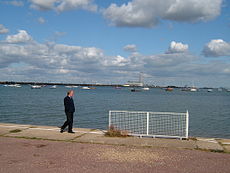
The Strand was once owned by the Davenport family in 1635, the Davenport family included a Mayor of Gillingham,[2] pie makers and key holders of Gillingham. The Davenport family had a road named after them in 1920. The Davenport Estate was in Ashford, Kent. The Estate was around 15000 acres and was called The Davenport Manor. The Davenport lost the Estate in 1889. The Davenport family was one of the Investors in the Chatham Dockyard.
In the Middle Ages the part of Gillingham known as Grange was a limb of the Cinque Ports [3] and the maritime importance of the area continued until the late 1940s. Indeed, a large part of Chatham Dockyard lay within Gillingham: the dockyard started in Gillingham and, until the day it was closed in 1984, two thirds of the then modern-day dockyard lay within the boundaries of Gillingham. The dockyard was founded by Queen Elizabeth I on the site of the present gun wharf, the establishment being transferred to the present site about 1622.
In 1667 a Dutch fleet sailed up the River Medway and, having landed at Queenborough on the Isle of Sheppey and laying siege to the fort at Sheerness, invaded Gillingham in what became known as the raid on the Medway. The Dutch eventually retreated, but the incident caused great humiliation to the Royal Navy.
The Seven Years' War began in 1756 and the government immediately gave orders for the defence of the dockyard; by 1758 the Chatham Lines of Defence were built. Over a mile long, they stretched across the neck of the dockyard peninsula, from Chatham Reach, south of the dockyard, across to Gillingham Reach on the opposite side. One of the redoubts on the Lines was Fort Amherst. The batteries faced away from the dockyard itself to forestall an attack from the landward side; the ships and shore-mounted guns on the river were considered sufficient to protect from that side. The lines of defence are now part of the Great Lines Heritage Park and also the Lower Lines Park.
War with France began again in 1778, and once more it was necessary to strengthen the defences. Fort Amherst was the first to be improved; it was followed by work beginning in 1800 to add others at Fort Pitt, Chatham, plus Fort Delce and Fort Clarence (both in Rochester); later in the 19th century others were added, including one at Fort Darland in Gillingham. Within all these buildings a barracks was built to house the soldiers. All this work, and the expansion of the dockyard, meant that more homes were needed for the workers. The position of the Lines meant that this building could only happen beyond, and so New Brompton came into being. The population rose to 9,000 people by 1851.
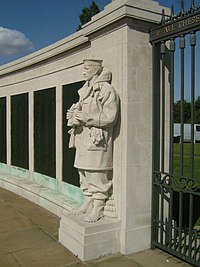
Gillingham was still only a small village; eventually it, too, was swallowed up, and the name of the whole became Gillingham. In the 1891 census its population was 27,809, and in 1901, it was 42,530.
In 1919, after First World War, a naval war memorial in the shape of a white stone obelisk was set up on the Great Lines, from where it can be seen for many miles. By 1901 Gillingham had a population in excess of 40,000.[4] Additional structures were added in 1945 to commemorate the dead of Second World War. Similar monuments stand in the dockyard towns of Portsmouth and Plymouth.
Churches
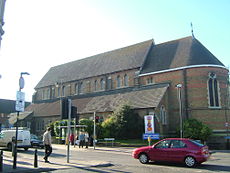
- Church of England:
- St Mary Magdalene
- St Mark's
- St Augustine's
- Baptist
- Methodist
- Roman Catholic
The Parish Church is St Mary Magdalene ("The Church on the Green") which dates back to the twefth century. It is the oldest building in Gillingham.[5]
Economy
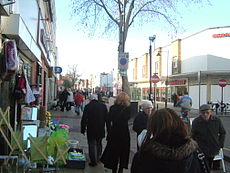
The main source of employment was at Chatham Dockyard, two-thirds of which lay within the boundaries of Gillingham. When it ceased to be a naval base in 1984, there was significant unemployment. A World Heritage Site application is today planned for the Dockyard and its defences.[6]
Since the '80s, Gillingham has rebuilt its economic base and the Gillingham Business Park was set up 3 miles from the town centre, in order to attract investments and diversify economic activity. The business park is one of the most popular business locations in North Kent and is located about two miles north of the M2 motorway.
Gillingham has a marina called Gillingham Marina. Gillingham is an important retail centre serving a substantial part of Medway. The town has a large street market in the High Street on Saturdays and Mondays, and is the busiest in the whole of Medway.[7]
Transportation
The Roman road known as Watling Street passes through Gillingham and until the opening of the M2 motorway in the mid-1960s the same route was followed by the traffic on the A2 to Dover. In June 1996 the Medway Tunnel opened, linking Gillingham with the M2 and Strood.
The London, Chatham and Dover Railway opened its line between Chatham and Faversham on 25 January 1858 and a country station was opened here called New Brompton to serve the dockyard labourers' homes that had sprung up during the Napoleonic Wars. A branch line led into the dockyard. New Brompton became later Gillingham Station.
Military
Brompton Barracks have long been the home of the Royal Engineers. Today Gillingham is home to the Royal Engineers Museum, one of the most important for military engineering history
Local media
- Newspapers (free newspapers):
- The Medway Messenger
- The Medway Extra
- yourmedway
- Radio:
- KMFM Medway
- Radio Sunlight
Outside links
| ("Wikimedia Commons" has material about Gillingham, Kent) |
- Archive Images
- Churches:
- Riverside Country Park, New Rainham
- History of Rainham and Gillingham
- A World Heritage Site application for Chatham Dockyard and its Defences
- Medway Urban Parks & Green Spaces Forum (MUP&GSF)
- Friends of Berengrave
- Historic Medway
References
- ↑ WILL ADAMS: Gillingham’s own Samurai
- ↑ http://cityark.medway.gov.uk/query/results/?Mode=Search&PathList=&SearchWords=de0402_21&DateList
- ↑ Medway Memories
- ↑ Nigel Yates, Kent in the Twentieth Century
- ↑ http://www.britishlistedbuildings.co.uk/en-172913-church-of-st-mary-st-mary-hoo-
- ↑ Chatham Dockyard World Heritage Site application
- ↑ Gillingham Town Centre Development Framework
